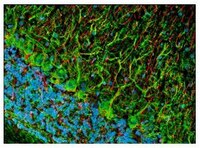NE1017 Sigma-AldrichAnti-Pan-Neuronal Neurofilament Marker Mouse mAb (SMI-311)
This Anti-Pan-Neuronal Neurofilament Marker Mouse mAb (SMI-311) is validated for use in ELISA, Frozen Sections, WB, ICC, Paraffin Sections for the detection of Pan-Neuronal Neurofilament Marker.
More>> This Anti-Pan-Neuronal Neurofilament Marker Mouse mAb (SMI-311) is validated for use in ELISA, Frozen Sections, WB, ICC, Paraffin Sections for the detection of Pan-Neuronal Neurofilament Marker. Less<<Recommended Products
Přehled
| Replacement Information |
|---|
Tabulka spec. kláve
| Species Reactivity | Host | Antibody Type |
|---|---|---|
| Ma | M | Monoclonal Antibody |
| References | |
|---|---|
| References | Agostino, A., et al. 2003. Hum. Mol. Genet. 12, 399. Tsunoda, I., et al. 2003. Am. J. Pathol. 162, 1259. Ulfig, N., et al. 1998. Cell Tissue Res. 291, 433. |
| Product Information | |
|---|---|
| Form | Liquid |
| Formulation | Undiluted ascites. |
| Positive control | Rat brain or rat CNS cytoskeletal preparations |
| Preservative | ≤0.1% sodium azide |
| Quality Level | MQ100 |
| Physicochemical Information |
|---|
| Dimensions |
|---|
| Materials Information |
|---|
| Toxicological Information |
|---|
| Safety Information according to GHS |
|---|
| Safety Information |
|---|
| Product Usage Statements |
|---|
| Packaging Information |
|---|
| Transport Information |
|---|
| Supplemental Information |
|---|
| Specifications |
|---|
| Global Trade Item Number | |
|---|---|
| Katalogové číslo | GTIN |
| NE1017 | 0 |
Documentation
Anti-Pan-Neuronal Neurofilament Marker Mouse mAb (SMI-311) MSDS
| Title |
|---|
Anti-Pan-Neuronal Neurofilament Marker Mouse mAb (SMI-311) Certificates of Analysis
| Title | Lot Number |
|---|---|
| NE1017 |
References
| Přehled odkazů |
|---|
| Agostino, A., et al. 2003. Hum. Mol. Genet. 12, 399. Tsunoda, I., et al. 2003. Am. J. Pathol. 162, 1259. Ulfig, N., et al. 1998. Cell Tissue Res. 291, 433. |














